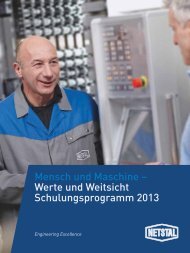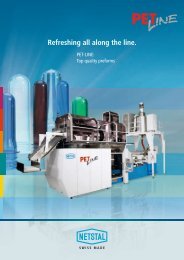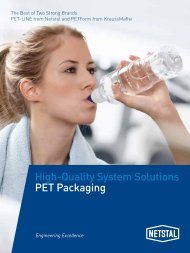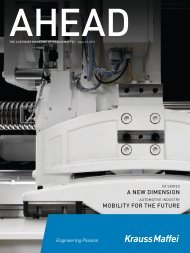E_KM_AHEAD-Magazin_2-12.pdf - Netstal
E_KM_AHEAD-Magazin_2-12.pdf - Netstal
E_KM_AHEAD-Magazin_2-12.pdf - Netstal
You also want an ePaper? Increase the reach of your titles
YUMPU automatically turns print PDFs into web optimized ePapers that Google loves.
20 Processes & Products<br />
<strong>AHEAD</strong> Issue 02.2012<br />
Processes & Products<br />
EFFIcIENT MANUFAcTUrING oF<br />
FIBEr coMpoSITE coMpoNENTS<br />
KraussMaffei offers an entire range of processes to manufacture fiber composite components (also see the<br />
cover story on page 5). The latest processes include different variants of resin injection processes. Here is a<br />
brief overview of the latest developments.<br />
New process variants expand the RTM (resin transfer molding)<br />
technology application field Fiber-reinforced plastic parts are characterized<br />
by extremely low weight but high rigidity. “Which manufacturing<br />
process is best suited to a specific component depends on numerous<br />
factors,” said Erich Fries, “above all, the component shape,<br />
the matrix material, and the quantity required are all influencing factors.”<br />
The performance profile and the production costs of the component<br />
are also critical criteria. They determine which solution approaches<br />
and manufacturing processes should be taken into account.<br />
High-pressure resin transfer molding (HP-RTM) with quick reacting<br />
resin systems The HP-RTM process (High-pressure resin transfer<br />
molding) is suitable for large series manufacturing of lightweight<br />
and high-strength structural components made of epoxy resins.<br />
However, polyurethane or other reaction resins can also be used as<br />
matrix materials. In HP-RTM, the resin is fed into the closed mold<br />
using a self-cleaning high-pressure mixing head. The resin and hardener<br />
components are injected into the mixing chamber via separate<br />
nozzles and are mixed there quickly and intensely. This technique allows<br />
fast-reacting resin systems to be processed within short reaction<br />
times. Using high-pressure injection, the matrix resin wets the<br />
fibers faster, more intensely, and more completely than by using the<br />
low-pressure technique.<br />
The mold can be evacuated and operated with an inner pressure of up<br />
to approximately 100 bar. Even complex, three-dimensional cavities<br />
are filled faster this way and the fibers inside are saturated. At the<br />
same time, air voids are eliminated. There are constant new customer<br />
requirements in the emerging lightweight construction and fiber<br />
composite materials sector. KraussMaffei continuously develops its<br />
process and machine technology for this dynamic environment.<br />
Compression resin transfer molding (C-RTM) and wet molding<br />
– two new HP-RTM variants In C-RTM, the mold is not completely<br />
closed initially, but only up to the defined gap. Next, the resin mixture<br />
enters the mold, with or without low mold-internal pressure. Some of<br />
the fibers are already saturated by the resin; the greater part of the<br />
resin quantity, however, is virtually “floating” on the fiber above. This<br />
is followed by a compression stroke – the mold is completely closed<br />
and the cavity corresponds to the shape of the final component. The<br />
compression stroke has the effect of pushing the resin through the<br />
fiber in the Z-direction and the fiber is wetted completely. This process<br />
is advantageous for delicate preforms due to the low material<br />
flows.<br />
KraussMaffei is providing another alternative to the automated series<br />
production of fiber-reinforced lightweight components in the form of<br />
the wetmolding procedure. Here, a fiber pile is fixed in a flat state<br />
without preforming. The mixing head is not positioned directly on the<br />
mold, but is fixed on a traversing unit. While the mixing head moves<br />
in a line over the fiber stack, the application device applies a laminar<br />
thin resin layer on the fiber stack. As soon as the fibers are covered<br />
with resin, the fiber pile is transported to a mold and pressed<br />
there. The preforming of the fibers in wetmolding thus takes place<br />
first with the mold closing movement. An important advantage of the<br />
wet-molding process is that even recycled fibers can be used to reinforce<br />
components. MB<br />
c-rTM, coMprESSIoN rTM<br />
10.<br />
9.<br />
8.<br />
1. 2.<br />
7.<br />
1. Semifinished products from<br />
the roll<br />
2. Handling the readymade<br />
semifinished products<br />
3. Transfer to the preform station<br />
4. Preforming<br />
5. Transfer the preform to the<br />
CRTM station<br />
6.<br />
6. Close the mold on the compression<br />
stroke, vacuum (optional)<br />
7. Resin injection<br />
8. Press (compression)<br />
9. Hardening<br />
10. Component removal<br />
3.<br />
5.<br />
4.








